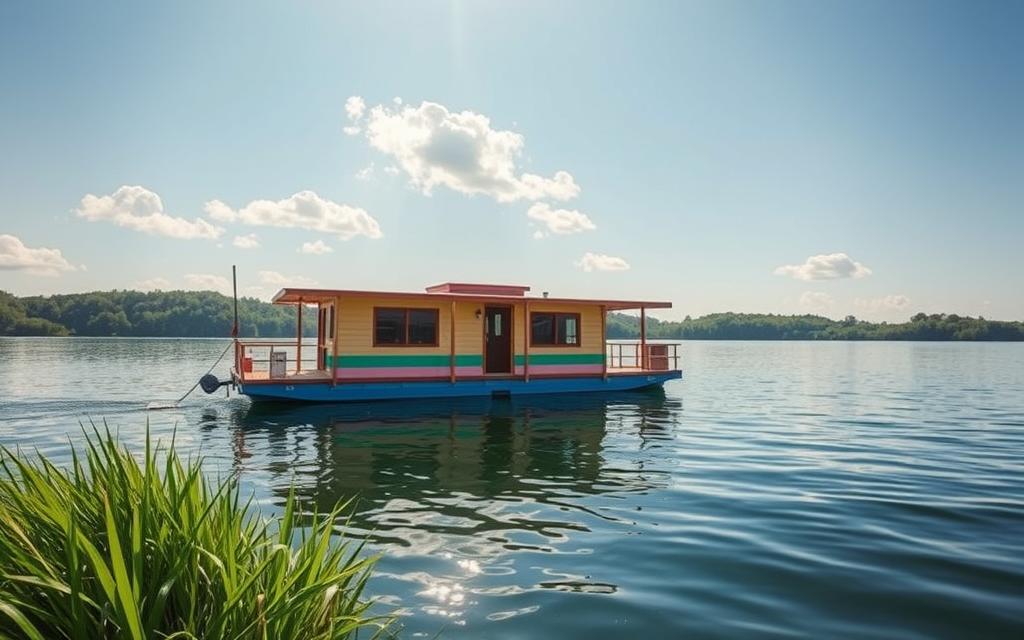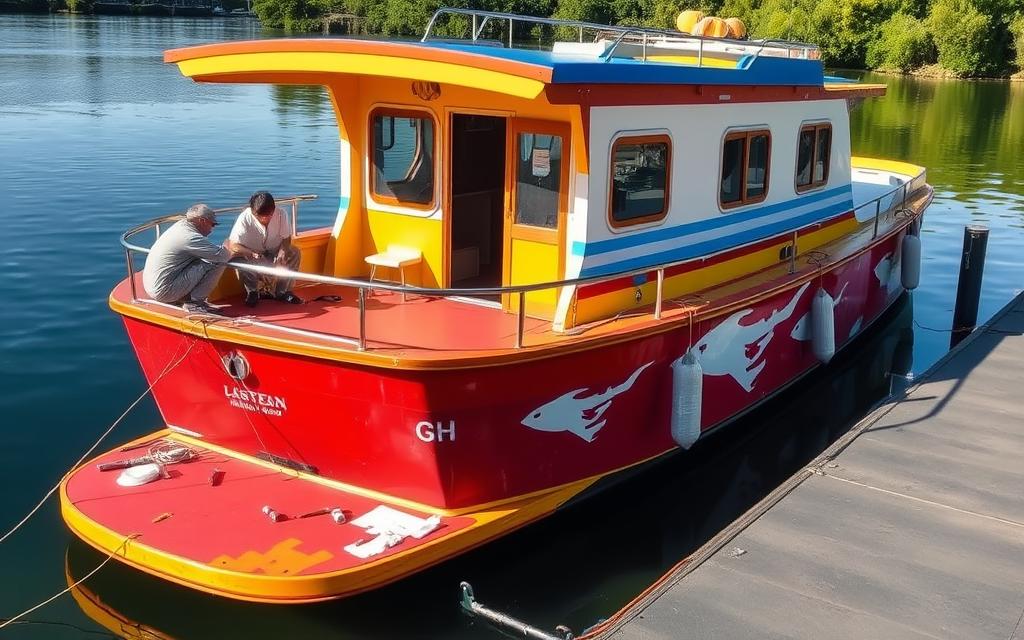Table of Contents
Are houseboat paints for long-lasting Protection? Yes, Protecting your houseboat means picking the right marine coatings. These must stand up to tough water environments. As a marine coating expert, I know how vital it is to choose paint that lasts and protects well.

Finding the right UV-resistant and anti-fouling paint can be tricky. Houseboats deal with constant water, sunlight, and environmental factors. They need special coatings to handle these challenges.
This guide offers detailed advice on the best paints for houseboats. It helps you make smart choices to protect your watercraft investment.
Key Takeaways
- Marine grade coatings are essential for long-term houseboat protection
- UV-resistant finishes prevent degradation from sunlight exposure
- Anti-fouling paint reduces marine organism buildup
- Proper paint selection extends vessel lifespan
- Professional application ensures maximum paint performance
Understanding Marine-Grade Paint Requirements for Houseboats
Choosing the right marine grade paint for your houseboat is key to protecting it. Marine environments are tough, needing special paint solutions. These go beyond regular paint.
Houseboats face harsh conditions that test paint durability. Paints must handle water, UV rays, and physical stress. Research shows important factors for effective marine coatings.
Environmental Challenges for Houseboat Paints
- Constant water exposure
- Intense UV radiation
- Temperature fluctuations
- Potential physical abrasion
Key Components of Marine-Grade Coatings
| Component | Function | Performance Impact |
|---|---|---|
| Epoxy Resins | Base protection layer | High adhesion and chemical resistance |
| Polyurethane Additives | Surface durability | Enhanced abrasion-resistant formulas |
| UV Inhibitors | Color and material protection | Prevents degradation from sunlight |
Impact of Water Types on Paint Selection
Different waters affect paint choice. Long-lasting boat finishes need to match your water type. Whether it’s freshwater lakes, saltwater coasts, or brackish waters, the right paint is essential.
“The right paint is your houseboat’s first defense against environmental wear and tear.” – Marine Coating Expert
Choosing durable topside paints is vital. Saltwater areas need stronger protection than freshwater. This makes paint selection a big decision for houseboat owners.
Houseboat Paints for Long-Lasting Protection
Choosing the right paint for your houseboat is key for lasting protection. High-performance topcoats have changed marine paint, giving unmatched durability. They also protect against harsh water environments.
When picking anti-fouling coatings, look for a few important traits:
- Abrasion-resistant paints that stand up to constant water
- Moisture-resistant formulas that prevent damage
- Eco-friendly boat paints that protect your boat and the sea
“Quality marine paint is an investment in your houseboat’s longevity and performance.” – Marine Engineering Expert
Today’s marine paints bring new innovations. Advanced polymer technologies create layers that fight UV damage, saltwater corrosion, and wear. These new solutions offer long-lasting protection with little upkeep.
Top brands like Interlux and Sherwin-Williams offer durable options. Their marine coatings use special chemicals to form strong barriers. These barriers fight water, sun, and mechanical stress.
- Opt for paints with multiple protective layers
- Look for UV and moisture resistance
- Choose eco-friendly options
Investing in high-quality marine paints keeps your houseboat safe, looking good, and strong for years.
Essential Features of UV-Resistant and Weather-Proof Coatings
Keeping your houseboat safe from harsh weather needs you to know about marine coatings. Waterproof paints are key in keeping your boat strong and looking good, even in tough weather.
UV Protection Technologies in Modern Boat Paints
New UV protection tech has changed the game for houseboat finishes. These coatings have special additives that:
- Block harmful ultraviolet radiation
- Prevent color fading and material degradation
- Extend the lifespan of marine surfaces
Weather-Resistant Properties and Benefits
Weather-resistant paints offer great protection. They have special features that make them stand out:
| Property | Protection Level | Performance Impact |
|---|---|---|
| Chemical Resistance | High | Prevents material breakdown |
| Flexibility | Excellent | Reduces cracking and peeling |
| Moisture Barrier | Superior | Prevents water penetration |
Long-Term Performance Factors
The lasting power of marine coatings depends on a few key things. Choosing top-notch paints with strong adhesion and resistance to weather stressors keeps your houseboat safe for many years.
Investing in premium marine coatings is not an expense, but a long-term protection strategy for your watercraft.
Anti-Fouling Paint Solutions for Below-Waterline Protection
Keeping your houseboat’s hull free from marine growth is key to its performance. Anti-fouling paints are vital for protecting the underwater parts from harmful buildup.
There are different types of marine-grade coatings for below-waterline protection:
- Hard anti-fouling paints
- Ablative coating systems
- Self-polishing marine-grade coatings
“Choosing the right exterior boat paints can significantly reduce marine growth and improve your vessel’s overall performance.”
Each type of anti-fouling paint has its own benefits. Hard coatings are tough and prevent marine organisms from sticking. Ablative paints slowly release chemicals to stop growth.
| Paint Type | Performance | Duration |
|---|---|---|
| Hard Anti-Fouling | High resistance | 1-2 seasons |
| Ablative Coatings | Moderate protection | 1-3 seasons |
| Self-Polishing | Consistent defense | 2-4 seasons |
When picking boat paint, think about the water, how you use your boat, and the rules. Now, there are eco-friendly paints that work well and are good for the environment.
Top-Rated Topside Paints for Above-Water Applications
Choosing the right paint for your houseboat’s top surfaces is key. It must look good and protect against the sun and sea. The best paint offers UV protection and lasts long.
High-Gloss vs. Satin Finish Options
When picking between high-gloss and satin finishes, know what each offers. High-gloss paints shine brightly and protect well against UV rays. They also clean up easily.
- Exceptional shine and reflection
- Enhanced UV protection
- Easier cleaning capabilities
Satin finishes have their own perks. They look softer and hide imperfections better. Plus, they don’t glare as much in sunlight.
- Softer, more subtle appearance
- Better hide surface imperfections
- Reduced glare under bright sunlight
Application Techniques for Maximum Durability
Applying mildew-resistant paints needs skill. Start with a corrosion-resistant primer. Then, apply thin, even layers of abrasion-resistant topcoat for the best protection.
Color Selection and Maintenance Considerations
Color does more than just look good. Light colors reflect heat, keeping surfaces cooler. Think about:
- Heat absorption rates
- UV resistance
- Long-term color retention
“The right paint protects your investment while maintaining your houseboat’s visual appeal.” – Marine Coating Experts
Regular care, like yearly checks and touch-ups, keeps your paint looking new. It also fights off sea damage.
Eco-Friendly Paint Options for Sustainable Boating
As a responsible houseboat owner, I’ve found exciting eco-friendly paints. These protect your boat and the marine environment. Modern paints meet the need for sustainable protection without losing quality.

Now, there are sustainable marine paint technologies for eco-conscious boaters. These epoxy paints last long and are kind to the environment.
- Water-based formulations with reduced VOC emissions
- Paints made from renewable resources
- Biodegradable coating technologies
- Minimal marine ecosystem disruption
What makes eco-friendly marine paints great includes:
| Feature | Environmental Benefit | Performance Impact |
|---|---|---|
| Low VOC Content | Reduced Air Pollution | Comparable Durability |
| Renewable Materials | Sustainable Sourcing | Strong Protective Qualities |
| Biodegradable Components | Minimal Marine Contamination | Long-Lasting Protection |
“Choosing eco-friendly paints is not just about protection—it’s about preserving our marine ecosystems for future generations.”
By picking eco-friendly paints, you protect your houseboat and help marine conservation. The newest eco-friendly paints show that being green and effective can go together.
Professional Application Techniques and Best Practices
Painting your houseboat needs precision and planning. Using professional methods can greatly improve its look and protection. I’ll show you how to get a perfect finish that keeps your boat safe from the sea.
Surface Preparation Essentials
Getting your surface ready is key for lasting boat paint. Start with a deep clean that includes:
- Removing old paint and dirt
- Sanding to smooth out the surface
- Cleaning with special marine solutions
- Using a top-notch primer for better paint stick
Selecting the Right Tools
The right tools are vital for applying boat paint. Here’s what you should have:
| Tool Type | Best Use | Recommended Brand |
|---|---|---|
| Rollers | Large flat areas | Wooster Sherlock |
| Brushes | Details and edges | Purdy XL Series |
| Sprayers | Even coverage of anti-fouling paints | Graco Airless Sprayer |
Optimal Weather Conditions for Application
The weather is important for painting your boat. Ideal conditions are:
- Temperature between 50-85°F
- Humidity between 40-70%
- No direct sunlight or rain
- Light winds
“The success of your marine paint job depends 80% on preparation and 20% on application.” – Professional Marine Painter
By using these professional methods, you’ll get a durable, protective finish for your houseboat. It will be ready to face the sea’s challenges.
Maintenance Tips for Extended Paint Life

Keeping your houseboat’s paint in top shape is key. It helps keep your boat looking great and strong. To do this, you need to take care of the paint in a smart way.
Regular cleaning is the first step in keeping your paint looking good. I suggest making a routine to protect your paint from the elements.
- Wash your houseboat every 4-6 weeks using soft cloths and marine-specific cleaning solutions
- Inspect surfaces for early signs of wear or damage
- Apply rust-inhibiting houseboat paints in areas prone to corrosion
- Touch up small chips or scratches immediately to prevent further deterioration
High-performance houseboat paint brands usually have special care tips. Always follow the manufacturer’s instructions to make your paint last longer.
“Preventative maintenance is always less expensive than complete repainting” – Marine Paint Experts
Important steps include keeping your paint away from too much sun, using gentle cleaners, and fixing problems fast. By doing these things, you’ll make your houseboat’s paint last longer. And you’ll keep your investment safe.
Choosing Between Different Paint Brands and Types
Choosing the right UV-resistant houseboat topcoats can be tough. The paint market has many options. It’s important to pick wisely for the best protection.
Cost Comparison Analysis
When looking at boat painting, don’t just think about the cost. UV-resistant paints have different long-term values:
- Initial purchase price
- Coverage rates
- Durability expectations
- Maintenance costs
Performance Reviews and Ratings
My research shows how important paint performance is. Different brands do well in different areas:
| Brand | UV Resistance | Price Range | Durability Rating |
|---|---|---|---|
| Interlux | Excellent | $$ | 9/10 |
| Petit | Very Good | $ | 8/10 |
| Sea Hawk | Good | $$$ | 9.5/10 |
Application Difficulty Levels
Knowing how hard it is to apply paint helps. Some paints need pros, while others are easy for DIY folks.
“Selecting the right paint is as important as how you apply it.” – Marine Paint Expert
- Single-part paints: Easier to apply
- Two-part epoxy: More complex, but better protection
- Polyurethane coatings: For a pro-grade finish
Your choice depends on your budget, skill, and what your houseboat needs. Think carefully to get lasting, beautiful protection.
Conclusion
Choosing the right marine paints for your houseboat is more than looks. It’s a key step in protecting your boat. We’ve looked at different boat paint brands and how they protect against salt water and moisture.
Aluminum boat paints offer special protection for various boats. It’s important to pick the right paint for your boat’s material and where you use it. High-quality marine paints fight off UV rays, water damage, and damage to the boat’s structure.
Your paint choice should consider performance, the environment, and cost. Using top-notch coatings and applying them correctly will make your boat last longer. It will also keep it looking great for many adventures on the water.
Take the time to find paint that fits your boat’s needs. The right marine paint is an investment in your boat’s safety and value.
FAQ
What are the most important factors to consider when choosing a houseboat paint?
When picking a houseboat paint, focus on a few key things. Look for UV resistance and moisture protection. Also, check for durability and anti-fouling properties. Make sure it’s compatible with your water environment.
Choose marine-grade coatings for long-lasting protection. They should withstand saltwater, sun, and biological growth.
How often should I repaint my houseboat?
Repainting frequency varies. I suggest repainting every 3-5 years for moderate conditions. But, it depends on paint quality and environmental stressors.
Regular checks and touch-ups can help. They keep your paint job looking good and protect your boat.
Are eco-friendly boat paints as effective as traditional marine paints?
Eco-friendly boat paints have improved a lot. Many now match traditional paints in performance. They offer UV protection, durability, and anti-fouling while being better for the environment.
Look for low VOC content and marine environmental certifications.
What’s the difference between topside and bottom paints for houseboats?
Topside paints protect the boat’s surface from UV and weather. Bottom paints prevent marine growth. Use specialized paints for each area to tackle different challenges.
How can I prepare my houseboat surface for painting?
Good surface prep is key. Clean the surface well, remove old paint, and sand it smooth. Apply a marine primer.
Make sure the surface is dry and free of moisture. Check for repairs before painting.
What are the most common mistakes in houseboat painting?
Common mistakes include poor prep, painting in bad weather, and using the wrong paint. Also, painting too thickly or thinly, skipping primer, and not maintaining the paint.
How do I choose between different marine paint finishes?
Choose based on your needs. High-gloss shows imperfections but looks shiny. Satin is softer and hides flaws better. Matte looks uniform but needs more care.
Consider your style, environment, and maintenance skills.
What’s the best way to protect my houseboat paint from UV damage?
To fight UV damage, use UV-resistant paints and clear topcoats. Wash and wax the surface regularly. Use covers when not in use.
Choose light colors and apply UV sealants as needed.


